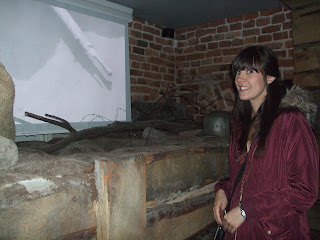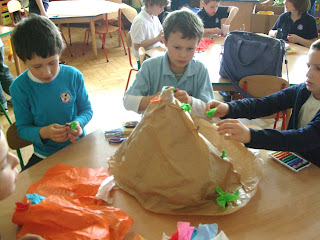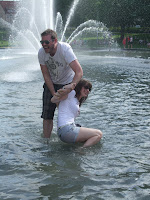 |
| At Stan's house |
This
week saw the conclusions of all our university classes as well as our final
days of placement. At the end of each class we were given a certificate with
our grades which was very nice to get, particularly as we all did very well.
One lecturer even went so far as to invite our class to his house at the end of
the week. This was a great opportunity for us to see what a Polish home is
like, something we had not yet been able to do. I found the afternoon to be a
particularly enjoyable experience as it was my first time inside a house in
four months (!) and I hadn’t realised quite how much I missed it. Student halls
definitely do not compare to a proper house! Stan’s invitation was a real
example of how hospitable the Polish people can be and we all really appreciated
it, especially all the buns his wife had baked.
 |
| At the Euro 2012 Fanzone |
As
the week continued, and we made our way through our list of things we wanted to
do before leaving, I was able to compare how I feel about Poznan and being on
Erasmus now, and how I felt while writing my first few blogs. I definitely
found the first few weeks here quite hard and took a while to settle in.
Although it took me a while, I did eventually settle in and I really enjoyed
being on Erasmus. I am extremely glad that I decided to take this opportunity,
particularly as I nearly didn’t and then ended up applying late. One of the
reasons why I hadn’t originally applied for Erasmus was because none of my
friends wanted to go and I didn’t want to go alone. I then decided to just
apply alone and I was grouped with Anna and Michael, two people who I barely
knew. After spending four months together the three of us are great friends and
I know that I am really going to miss seeing them every day, particularly as we
spend most of our time together constantly laughing. I think this is something
which will take a bit of time to get used to, particularly as Anna and I are
roommates here and so really have got to know each other very well. Had I not
have applied for Erasmus I would have most likely gone through university without
ever getting to know these two people due to not having had any classes
together. I feel this would be a real shame and I am very thankfully to have
made two great friends.
 |
| One of our final meals together |
While
I was sad that the three of us wouldn’t be able to spend as much time together
any more, it will obviously be easier to meet up with Anna and Michael than
with the other friends I have made during my time here. My two teachers from
school, Kasia and Jo, arranged to meet up with me for lunch the day before I
left which I really appreciated and it was nice to spend some more time with
them before leaving. Towards the end of the week we also had several leaving
parties with our Erasmus friends which meant that we were able to spend some
quality time together before going our separate ways. Poznan was beginning to
get particularly crazy as many of the Euro 2012 football matches are being held
in Poland. This meant that the city was starting to fill up with football fans,
including thousands of Ireland supporters. I feel that I left Poznan at a
perfect time. I was still happy to be there, so I left with happy memories,
rather than staying longer and becoming homesick and fed up.
As
I finish my final blog, I am able to reflect on the past few months and know
that I made the right decision to go on Erasmus and make the most of an
opportunity that I am not likely to ever get again.
 |
| With my class |
 |
| Some goodbye cuddles |
Do widzenia,
DarÓma.
























